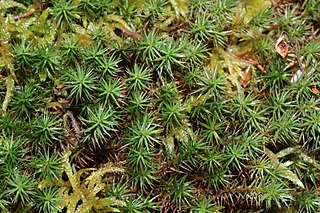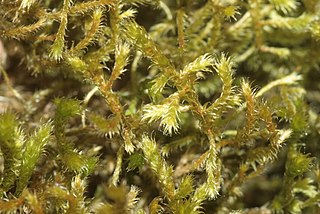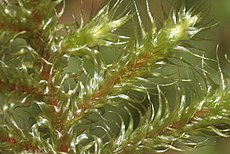
An epiphyte is a plant or plant-like organism that grows on the surface of another plant and derives its moisture and nutrients from the air, rain, water or from debris accumulating around it. The plants on which epiphytes grow are called phorophytes. Epiphytes take part in nutrient cycles and add to both the diversity and biomass of the ecosystem in which they occur, like any other organism. They are an important source of food for many species. Typically, the older parts of a plant will have more epiphytes growing on them. Epiphytes differ from parasites in that they grow on other plants for physical support and do not necessarily affect the host negatively. An organism that grows on another organism that is not a plant may be called an epibiont. Epiphytes are usually found in the temperate zone or in the tropics. Epiphyte species make good houseplants due to their minimal water and soil requirements. Epiphytes provide a rich and diverse habitat for other organisms including animals, fungi, bacteria, and myxomycetes.

Mosses are small, non-vascular flowerless plants in the taxonomic division Bryophytasensu stricto. Bryophyta may also refer to the parent group bryophytes, which comprise liverworts, mosses, and hornworts. Mosses typically form dense green clumps or mats, often in damp or shady locations. The individual plants are usually composed of simple leaves that are generally only one cell thick, attached to a stem that may be branched or unbranched and has only a limited role in conducting water and nutrients. Although some species have conducting tissues, these are generally poorly developed and structurally different from similar tissue found in vascular plants. Mosses do not have seeds and after fertilisation develop sporophytes with unbranched stalks topped with single capsules containing spores. They are typically 0.2–10 cm (0.1–3.9 in) tall, though some species are much larger. Dawsonia, the tallest moss in the world, can grow to 50 cm (20 in) in height. There are approximately 12,000 species.
Rhytidiadelphus triquetrus, the big shaggy-moss or rough goose neck moss, is a species of moss in the family Hylocomiaceae. It is often the dominating moss species in moderately rich forest habitats in the boreal regions and the Pacific Northwest. Because of its fuzzy appearance and tail-like shape it is also called the 'electrified cat's tail moss'. Not to be confused with square goose-necked moss, Rhytidiadelphus squarrosus.

Schistostega pennata, also called goblin gold, Dragon's gold,luminous moss or luminescent moss, is a haplolepideous moss (Dicranidae) known for its glowing appearance in dark places. It is the only member of the family Schistostegaceae.
Herbertus borealis is a species of liverwort in the family Herbertaceae known as northern prongwort. It was described in 1970 by Alan Crundwell. It is endemic to Scotland, where it is found only in the Beinn Eighe nature reserve, and lives in dwarf shrub heath alongside other large liverworts such as Anastrophyllum donnianum, Bazzania tricrenata and Pleurozia purpurea. A closely related species, described in 2012 as Herbertus norenus and known as "Viking prongwort", is known from Shetland and Norway and was formerly confused with H. borealis.

Radula is a genus of liverwort, and is the only genus in family Radulaceae.

Hylocomium splendens, commonly known as glittering woodmoss, splendid feather moss, stairstep moss, and mountain fern moss, is a perennial clonal moss with a widespread distribution in Northern Hemisphere boreal forests. It is commonly found in Europe, Russia, Alaska and Canada, where it is often the most abundant moss species. It also grows in the Arctic tundra and further south at higher elevations in, for example, northern California, western Sichuan, East Africa, Australia, New Zealand and the West Indies. In Scotland it is a characteristic species of the Caledonian Forest. Under the UK's national vegetation classification system, pinewood community W18 is named as "Pinus sylvestris-Hylocomium splendens woodland", indicating its significance in this ecosystem.

Pellia epiphylla is a species of thallose liverwort. It occurs in North America, Europe, North Africa and parts of Asia. It grows in patches in damp, sheltered places on neutral or acidic substrates. It is common on the banks of rivers, streams and ditches and also grows in wet woodland, marshes and on wet rocks.

Rhytidiadelphus squarrosus is a species of moss known as springy turf-moss in the United Kingdom, and square goose neck moss in the United States. It is widespread in Eurasia and North America, and has been introduced to the Southern Hemisphere. It has broad ecological tolerances, and is usually found in man-made habitats such as lawns and golf courses. It is most closely related to R. subpinnatus, with which it is often confused.

Zygodon gracilis, the slender yokemoss, is a moss species in the genus Zygodon. It is a rare lithophyte found to only grow on certain localities of limestone outcrops that has high calcium carbonate content. The current global conservation status of Z. gracilis is considered to be "imperiled".

Sphagnum palustre, the prairie sphagnum or blunt-leaved bogmoss, is a species of peat moss from the genus Sphagnum, in the family Sphagnaceae. Like other mosses of this type it can soak up water up to the 30-fold amount of its own dry weight thanks to its elastic spiral fibers. S. palustre is rather frequent and is spread almost all over the world. It mainly grows in wet forests and—compared to other specimens of this genus—rarely grows in moors.

Bartramia pomiformis, the common apple-moss, is a species of moss in the Bartramiaceae family. It is typically green or glaucous in hue, although sometimes it can appear yellowish. The stems extend from a half cm to 8 cm, with narrowly lanceolate to linear-lanceolate leaves 4 - 9 mm long. The leaves have a nerve and are toothed. They are curled when dry but stick out when moist.

Polytrichum juniperinum, commonly known as juniper haircap or juniper polytrichum moss, is an evergreen and perennial species of moss that is widely distributed, growing on every continent including Antarctica.

Calliergon cordifolium is a species of moss in the Calliergonaceae family, commonly known as the calliergon moss or heart-leaved spearmoss. The species is abundant in the right habitat, and grows in marshes and wet woodland, especially woodland of alder (Alnus) or willow (Salix), as well as around streams, ditches and pools. The species grows in tufts among other moss species. Calliergon cordifolium requires a wet environment to grow, and often grows completely submerged in water. It typically prefers lowland, but has been recorded as high as 910 metres (1,000 yd) above sea level in Inverness, Scotland. The species has a circumpolar Boreo-temperate distribution. It is found throughout Europe. It has been recorded in north and central Asia, as well as Turkey and Japan, throughout North America and in New Zealand.

Sphagnum squarrosum, commonly known as the spiky bog-moss or spreading-leaved bog moss is a species of moss which grows in nutrient-rich, damp soil. Typical habitats include woodland, the banks of streams and ditches; it can even be found at high altitude in damp cirques. The species often grows near sedges (Carex), rushes (Juncus) or purple moor grass.

Sphagnum fuscum, the rusty bogmoss or rusty peat moss, is a peat moss found commonly in Norway and Sweden, and can be found scattered across North America, the United Kingdom, and in southern to eastern Europe.

Polytrichum strictum, commonly known as bog haircap moss or strict haircap, is an evergreen and perennial species of moss native to Sphagnum bogs and other moist habitats in temperate climates. It has a circumboreal distribution, and is also found in South America and Antarctica.

Andreaea rothii, or Roth's andreaea moss, is a species of moss in the family Andreaeaceae native to North America and parts of Europe. This plant was described in 1807 by Weber and Mohr.

Antitrichia curtipendula is a species of feather-moss found predominantly in western North America and the western coast of Europe.

Polytrichum piliferum, the bristly haircap, is an evergreen perennial species of moss in the family Polytrichaceae. The bristly haircap moss is small-sized to medium-sized and forms loose tufts with wine-reddish stems. It is an acrocarpous moss that appears bluish-green to grey. This moss grows in clumps on erect shoots and becomes a red-brown colour as it grows older. The most distinguishing feature of P. piliferum is the long, white awn at the tips of the leaves, which also give this moss its grey colour. It is the only species in its genus where the awn is completely hyaline.
1.Crum, Howard; Anderson, Lewis Edward (1981). "Mosses of Eastern North America". New York: Columbia UP.
2.DeLuca, T.H. "Nitrogen Fixation Reactions." AccessScience (n.d.): n. pag. Web.
3. Fretwell, Kelly, and Brian Starzomski. "Lanky Moss • Rhytidiadelphus Loreus.Biodiversity of the Central Coast. The Starzomski Lab, 2013. Web. 28 Nov. 2016.
4. Godfrey, Martin. "Hypnales." Rhytidiadelphus Loreus (n.d.): n. pag. Rytidiadelpus Loreus, Little Shaggy- Moss. Web.
5. Montana Field Guide. "Rhytidiadelphus Loreus." Rhytidiadelphus Loreus - Montana Field Guide. State of Montana, n.d. Web. 28 Nov. 2016.
6. NatureServe. "Results Detailed Report." Results Detailed Report. The North Carolina Botanical Garden, n.d. Web. 28 Nov. 2016.
7. "Plants Profile for Rhytidiadelphus Loreus (goose Neck Moss)." Plants Profile for Rhytidiadelphus Loreus (goose Neck Moss). USDA: Natural Resources Conservation Service, n.d. Web. 28 Nov. 2016.
8. Schofield, Wilf. "E-Flora BC: Electronic Atlas of the Flora of British Columbia." Rhytidiadelphus Loreus: Lanky Moss. Spatial Data Lab, Department of Geography UBC, 2015. Web. 28 Nov. 2016.



















